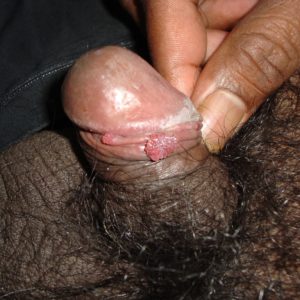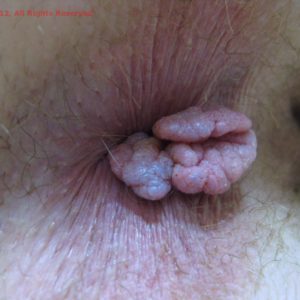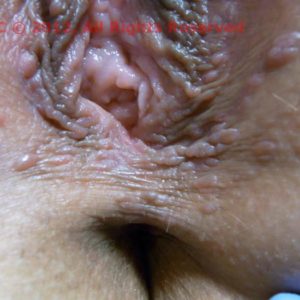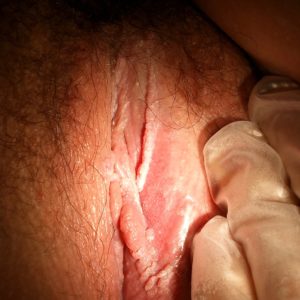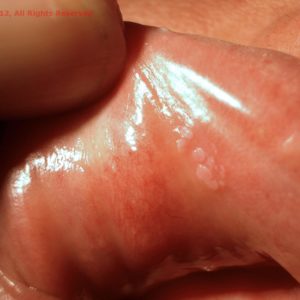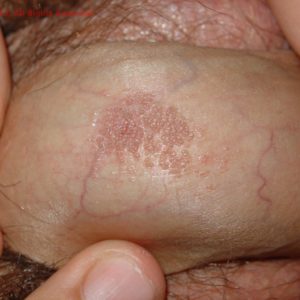Anal and Genital Warts (HPV)
Anal or genital warts are small, hard lumps caused by certain types of the human papillomavirus (HPV). Warts can appear around the genitals, anus, inside the vagina, rectum, and urethra. HPV is transmitted via genital skin-to-skin contact with a person who has HPV. Over 90% of adults carry at least one strain of genital HPV in their bodies, but not all strains cause visible symptoms, such as warts. Transmission can happen even when warts are not visible.
Because genital HPV is very common among all sexually active people, it may be challenging for sex workers who provide skin-to-skin genital contact to prevent exposure to HPV in a sex work setting. Staying up to date with cervical screening tests and getting vaccinated against HPV can significantly reduce your risk of getting genital warts and HPV-related cancers, such as cervical cancer.
Understanding HPV
There are over 200 strains of HPV, and many cause no health issues at all. Some kinds of HPV can cause genital warts, and others can cause cancer of the cervix, vagina, vulva, or anus. Most people who have genital HPV will not show any symptoms and will naturally control or clear the virus.
There is no cure for HPV itself, but there are treatments for the health problems that HPV can cause, such as genital warts, cervical changes, and cervical cancer. Vaccination can protect you against the HPV types that cause genital warts and most cervical and other HPV-related cancers.
Anal or genital warts are small, hard lumps caused by certain types of the human papillomavirus (HPV). Warts can appear around the genitals, anus, inside the vagina, rectum, and urethra. HPV is transmitted via genital skin-to-skin contact with a person who has HPV. Over 90% of adults carry at least one strain of genital HPV in their bodies, but not all strains cause visible symptoms, such as warts. Transmission can happen even when warts are not visible.
Because genital HPV is very common among all sexually active people, it may be challenging for sex workers who provide skin-to-skin genital contact to prevent exposure to HPV in a sex work setting. Staying up to date with cervical screening tests and getting vaccinated against HPV can significantly reduce your risk of getting genital warts and HPV-related cancers, such as cervical cancer.
Understanding HPV
There are over 200 strains of HPV, and many cause no health issues at all. Some kinds of HPV can cause genital warts, and others can cause cancer of the cervix, vagina, vulva, or anus. Most people who have genital HPV will not show any symptoms and will naturally control or clear the virus.
There is no cure for HPV itself, but there are treatments for the health problems that HPV can cause, such as genital warts, cervical changes, and cervical cancer. Vaccination can protect you against the HPV types that cause genital warts and most cervical and other HPV-related cancers.
Signs and Symptoms
HPV often has no symptoms (asymptomatic), but anal and genital warts can develop 1 to 20 months after exposure. It can take up to 10 years for a high-risk HPV infection to develop into cancer.
Vagina/Vulva
HPV can present no symptoms at all. If signs or symptoms are present, there may be:
- a cluster that looks like a cauliflower
- a scatter of bumps that are darker than unaffected skin
- growths that may be raised, flat, smooth, or rough
- abnormal bleeding during vaginal sexual activity or when passing urine or stool
Warts are usually indicative of low-risk (non-cancer-causing) HPV. One specific type of vulvar cancer may present as cauliflower-like growths, so you should speak to a doctor if you see any unusual growths around the vulva.
Penis
HPV can present no symptoms at all. If signs or symptoms are present, there may be:
- a cluster that looks like a cauliflower
- a scatter of bumps that are darker than unaffected skin
- growths that may be raised, flat, smooth, or rough
- warts that appear on your scrotum or in your pubic hair
- abnormal bleeding when passing urine or stool
Anus/Rectum
HPV can present no symptoms at all. If signs or symptoms are present, there may be:
- a cluster that looks like a cauliflower
- a scatter of bumps that are darker than unaffected skin
- growths that may be raised, flat, smooth, or rough
- abnormal bleeding during anal sexual activity or when passing urine or stool
Symptom Images (content warning: click or tap to expand)
Transmission
HPV is mainly transmitted through sexual contact, and most people are infected with HPV shortly after the onset of sexual activity. More than 90% of them clear the infection naturally.
- Genital skin-to-skin contact with a person who has HPV (e.g. penis/balls to vulva, vulva to vulva, penis to penis, anus to balls).
- HPV is highly contagious if a wart is visible or if the skin on the wart has been broken.
- HPV can be transmitted when no warts are visible
- Transmission can happen even when warts are not visible.
- It is also possible to transmit HPV from the genital area to the mouth, but this is very uncommon. There is growing evidence that HPV infection in the mouth and throat, transmitted through oral sex, is a major cause of throat cancer. For further information on HPV-related cancers see www.hpv.org.nz.
- Only the skin area covered by a condom, glove, dam or other barrier is protected from the virus.
- The appearance of warts does not indicate that you were exposed to HPV recently. You may have been exposed to HPV months or years before seeing the presence of warts.
Prevention
Vaccination
Getting vaccinated against HPV is the best way to protect against genital warts and other HPV-related illnesses.
- There are two types of vaccines available in Australia. Both provide immunity against 99% of all HPV types that cause genital warts and types 16 and 18, the HPV strains that cause 70% of cervical cancers.
- The vaccines provide protection from HPV for people of all gender identities.
- The vaccine cannot ‘cure’ an existing infection of HPV.
- HPV vaccines offer the most protection if they are taken before a person is sexually active and has been exposed to HPV.
- Vaccination may still provide you with protection against strains of HPV that you have not been exposed to since you started having sex.
- Free HPV vaccination was introduced in Australia in 2007, so you may have been vaccinated already as part of the National Immunisation Program. People under the age of 19 can obtain two doses of the vaccine for free.
- If you are not eligible for a free vaccine, you may need to pay for it. Your doctor can give you the best information.
- Some sexual health clinics may be able to vaccinate you for free. You can view a list of sex worker-friendly sexual health clinics on our Where To Test page.
Cervical Screening Test
Some types of HPV can cause cancer. Regular cervical tests will detect the virus on the cervix, and early treatment will substantially reduce the risk of cervical cancer. Eligible people aged 25 to 74 years of age should have a Cervical Screening Test every five years until the age of 74.
Anyone over 25 who has a cervix and has had sexual contact should have cervical screenings every five years, even if you have been vaccinated. This is because the vaccine does not protect against all types of HPV that cause cervical cancer.
See our Cervical Screening resource for more information.
The Cervical Screening Test (CST) is free for eligible people, but your doctor may charge their standard consultation fee for the appointment. Some doctors, sexual health clinics and health centres offer bulk billing, which means you don’t have to pay.
Use of condoms and dams
- Condoms and dams provide some protection from HPV transmission during sex, but they cannot provide complete protection.
- Only the skin area covered by a condom, glove, dam or other barrier is protected from the virus.
- Direct skin contact with other exposed skin areas (e.g., the testicles, vulva and buttocks) can transmit the virus during sex.
- There is always a risk of HPV transmission for any sexually active person. This cannot be avoided, no matter how careful you may be.
Testing
Here’s some information about testing for HPV. You can view a list of sex worker-friendly sexual health clinics on our Where To Test page.
Testing Method
- Physical or visual exam from your doctor or nurse
- Cervical screening tests are the best way to detect HPV if you have a cervix
When to Test
- If you or your partner develops bumps or warts in the genital area.
- If a sexual partner is diagnosed with genital warts or has some symptoms.
- All people with cervixes aged between 25 and 74 should get a Cervical Screening Test (CST) every five years (instead of a Pap test every two years, which has been replaced by the CST).
- We provide lots more information in our Cervical Screening Tests resource.
Other Info
- Some doctors, clinics and health centres offer bulk billing, which means there are no out-of-pocket expenses.
- There is currently no approved screening test for HPV for people who don’t have a cervix. If you are concerned that you might have HPV, speak to your doctor.
- Trans people who have a cervix and are aged 25 or over require cervical screening, no matter their hormonal history or gender identity. Here is some more information about navigating cervical screening.
- If you’ve had vaginoplasty, you can still test for the presence of HPV and look for any changes to the vaginal cells.
Treatment
No treatment has been demonstrated to get rid of HPV from the body or stop transmission. However, you can treat some of the symptoms.
Here’s what you need to know about treating HPV.
Treatment Method/s
- There are many treatments to remove warts depending on the size, number and location of warts.
- The most common treatment is one you can do yourself. You can buy and apply a medicated ‘paint’ called podophyllin. This is best suited for external warts that are easy to reach. Other treatments include freezing (cryotherapy), immune-boosting creams, or laser or surgical removal.
- Removing warts does not ‘cure’ HPV.
- It is very common for HPV symptoms to come back after treatment. If this happens, you will need to treat it again.
- Treatment is also available after an abnormal Cervical Screening Test result, depending on the type of cervical changes you have.
Costs and Other Information
- Warts will disappear in 10-20% of people within three to four months, even without treatment.
- Sexual health clinic treatments are often bulk billed. If you don’t have Medicare the treatment may be free.
- If you see a GP, you may pay a fee or be bulk billed.
How might this impact my work?
Practical Considerations
- The only real way to protect against an HPV infection is to abstain from sexual contact, which is unrealistic for most sex workers.
- If you have a high-risk strain, your doctor will discuss the next steps with you.
- Avoid having sex when you have genital warts you can see or feel, as this is when they are most contagious. If a client has warts, you might refuse service or provide an alternative service.
- It is recommended that you avoid sex during the treatment period if possible.
- Some treatments can weaken latex condoms and/or irritate the skin. Skin irritation or breakage can increase your risk of other STI.
- If you have warts removed, it is recommended that you wait until the skin heals to have sex. Open sores increase your risk of other STI/BBV.
- While it is still possible to spread HPV when the warts are gone, their lower viral levels make transmission less likely.
You Might Also Be Interested In…
What are BBV & STI?
Lorem ipsum dolor sit amet, consectetur adipiscing elit, sed do eiusmod tempor incididunt ut labore et dolore magna aliqua. Ut enim ad minim veniam, quis nostrud exercitation ullamco laboris nisi ut aliquip ex ea commodo consequat.
Testing Timeframes
Lorem ipsum dolor sit amet, consectetur adipiscing elit, sed do eiusmod tempor incididunt ut labore et dolore magna aliqua. Ut enim ad minim veniam, quis nostrud exercitation ullamco laboris nisi ut aliquip ex ea commodo consequat.
Alternative Services
Lorem ipsum dolor sit amet, consectetur adipiscing elit, sed do eiusmod tempor incididunt ut labore et dolore magna aliqua. Ut enim ad minim veniam, quis nostrud exercitation ullamco laboris nisi ut aliquip ex ea commodo consequat.
Testing Locations
Lorem ipsum dolor sit amet, consectetur adipiscing elit, sed do eiusmod tempor incididunt ut labore et dolore magna aliqua. Ut enim ad minim veniam, quis nostrud exercitation ullamco laboris nisi ut aliquip ex ea commodo consequat.







